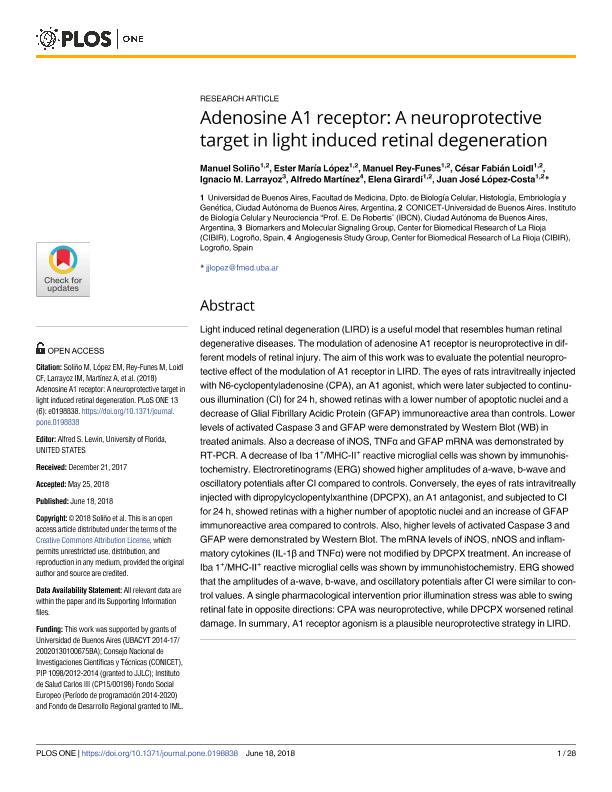Artículo
Adenosine A1 receptor: A neuroprotective target in light induced retinal degeneration
Soliño, Manuel; Lopez, Ester Maria ; Rey Funes, Manuel; Loidl, Cesar Fabian
; Rey Funes, Manuel; Loidl, Cesar Fabian ; Larráyoz, Ignacio M.; Martínez, Alfredo; Girardi, Elena Silvia
; Larráyoz, Ignacio M.; Martínez, Alfredo; Girardi, Elena Silvia ; López Costa, Juan José
; López Costa, Juan José
 ; Rey Funes, Manuel; Loidl, Cesar Fabian
; Rey Funes, Manuel; Loidl, Cesar Fabian ; Larráyoz, Ignacio M.; Martínez, Alfredo; Girardi, Elena Silvia
; Larráyoz, Ignacio M.; Martínez, Alfredo; Girardi, Elena Silvia ; López Costa, Juan José
; López Costa, Juan José
Fecha de publicación:
06/2018
Editorial:
Public Library of Science
Revista:
Plos One
ISSN:
1932-6203
Idioma:
Inglés
Tipo de recurso:
Artículo publicado
Clasificación temática:
Resumen
Light induced retinal degeneration (LIRD) is a useful model that resembles human retinal degenerative diseases. The modulation of adenosine A1 receptor is neuroprotective in different models of retinal injury. The aim of this work was to evaluate the potential neuroprotective effect of the modulation of A1 receptor in LIRD. The eyes of rats intravitreally injected with N6-cyclopentyladenosine (CPA), an A1 agonist, which were later subjected to continuous illumination (CI) for 24 h, showed retinas with a lower number of apoptotic nuclei and a decrease of Glial Fibrillary Acidic Protein (GFAP) immunoreactive area than controls. Lower levels of activated Caspase 3 and GFAP were demonstrated by Western Blot (WB) in treated animals. Also a decrease of iNOS, TNFα and GFAP mRNA was demonstrated by RT-PCR. A decrease of Iba 1+/MHC-II+ reactive microglial cells was shown by immunohistochemistry. Electroretinograms (ERG) showed higher amplitudes of a-wave, b-wave and oscillatory potentials after CI compared to controls. Conversely, the eyes of rats intravitreally injected with dipropylcyclopentylxanthine (DPCPX), an A1 antagonist, and subjected to CI for 24 h, showed retinas with a higher number of apoptotic nuclei and an increase of GFAP immunoreactive area compared to controls. Also, higher levels of activated Caspase 3 and GFAP were demonstrated by Western Blot. The mRNA levels of iNOS, nNOS and inflammatory cytokines (IL-1β and TNFα) were not modified by DPCPX treatment. An increase of Iba 1+/MHC-II+ reactive microglial cells was shown by immunohistochemistry. ERG showed that the amplitudes of a-wave, b-wave, and oscillatory potentials after CI were similar to control values. A single pharmacological intervention prior illumination stress was able to swing retinal fate in opposite directions: CPA was neuroprotective, while DPCPX worsened retinal damage. In summary, A1 receptor agonism is a plausible neuroprotective strategy in LIRD.
Palabras clave:
Adenosine
,
Retina
Archivos asociados
Licencia
Identificadores
Colecciones
Articulos(IBCN)
Articulos de INST.DE BIOLO.CEL.Y NEURCS."PROF.E.DE ROBERTIS"
Articulos de INST.DE BIOLO.CEL.Y NEURCS."PROF.E.DE ROBERTIS"
Citación
Soliño, Manuel; Lopez, Ester Maria; Rey Funes, Manuel; Loidl, Cesar Fabian; Larráyoz, Ignacio M.; et al.; Adenosine A1 receptor: A neuroprotective target in light induced retinal degeneration; Public Library of Science; Plos One; 13; 6; 6-2018; 1-28
Compartir
Altmétricas



